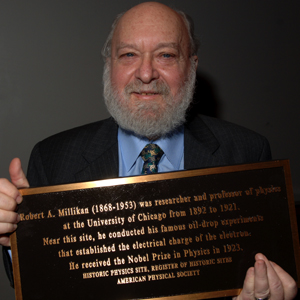Work of physicist Millikan continues to receive accolades
By Steve KoppesNews Office
 Robert Millikan | |
By the time Robert Millikan died in 1953, he had left his mark as a Nobel Prize-winning scientist, master teacher and provocateur. Millikan received the Nobel Prize in Physics in 1923 for two seminal research experiments, one on the elementary charge of electricity and the other on the photoelectric effect.
Although he performed both of his prize-winning experiments in the Ryerson Physical Laboratory on the University’s campus early in the 20th century, his work continues to receive accolades in the 21st.
Now, the American Physical Society has declared the University a historic physics site to commemorate the experiments Millikan conducted at Chicago that earned him the Nobel Prize.
Since 2004, the APS Historic Sites Committee has selected 11 historic physics sites that include Washington University in St. Louis, where Arthur Holly Compton performed his Nobel Prize-winning experiments before joining the faculty at Chicago, and Case Western Reserve University in Ohio, where 1907 Nobel laureate Albert Michelson did likewise. It was Michelson who appointed Millikan and, later, Compton to their faculty positions at Chicago.
Until late in the 19th century, Benjamin Franklin stood as the sole world-famous American physical scientist, said Leo Kadanoff, the John D. MacArthur Distinguished Service Professor Emeritus in Physics and the College. “But at the beginning of the 20th century, we started to produce world-famous scientists one after another, of whom two are particularly connected with the University: Michelson and Millikan,” said Kadanoff, President of the American Physical Society since Jan. 1, 2006. “We can be proud of the University’s contribution to their careers and to their effectiveness as scientists.”
Millikan was born in Morrison, Ill., in 1868. He received his Ph.D. from Columbia University and joined the Chicago faculty in 1897. Here he soon distinguished himself as a teacher and textbook writer. But physicists consider Millikan’s oil-drop experiment to be his greatest single intellectual contribution, said Kadanoff. In the experiment, Millikan measured the electrical charge of individual electrons, showing that electrical charge came in small units called “quanta.”
Also important was Millikan’s measurement of the photoelectric effect, Kadanoff said. The photoelectric effect is the emission of electrons that results when light strikes certain metal surfaces. Millikan’s measurement provided an important value for quantum mechanical equations, which describe physics on the subatomic scale.
“It’s remarkable that a single individual in independent experiments measured two of the most important quantities in all of physics,” Kadanoff said.
 Leo Kadanoff, the John D. MacArthur Distinguished Service Professor Emeritus in Physics and the College, holds the plaque on which the citation from the American Physical Society notes Robert Millikan’s research and the new honor it has earned the University. | |
Millikan also coined the term “cosmic rays,” which today are known to be subatomic scraps of matter from deep space that continuously strike the Earth. “He was one of the founders of the study of cosmic rays,” Kadanoff said. “In cosmic rays, you study radiation and charged particles from outer space. It is a logical continuation of the oil drop experiment.”
Millikan’s career veered toward administration in 1917, when he became vice chairman and director of research of the National Research Council. The council had been established by the National Academies of Science the previous year to help advise the federal government on science and technology.
In 1921, he moved west to head another new organization, the California Institute of Technology. During these and later years, Millikan displayed a “penchant for controversy,” according to an in-depth 1979 profile published in Scientific American. “The controversies centered on cosmic rays and on his attitude toward the relation between academic science and government,” the article said. “In both controversies Millikan was on the losing side.”
In his continuing research, he characterized cosmic rays as a highly energetic form of electromagnetic radiation that signaled the “birth cries of atoms” rather than the charged particles that other scientists thought them to be. Today, University scientists pursue an ambitious research agenda on high-energy cosmic rays as part of an international collaboration at the Auger Cosmic Ray Observatory in Argentina.
In the administrative arena, Millikan supported federal funding for university research, but worried about the political interference that might come with it. This concern led him to unsuccessfully advocate assigning the responsibility for federal funding decisions to the independent National Research Council.
The historic sites program honoring Millikan’s contribution is part of a larger APS educational and public outreach effort, Kadanoff said. “We are working to achieve the goals of the American Competitiveness Initiative in which Congress, interested citizen groups and the administration are working to improve the capabilities of the U.S. economy by building up our physical sciences,” he said.
![[Chronicle]](/images/sidebar_header_oct06.gif)